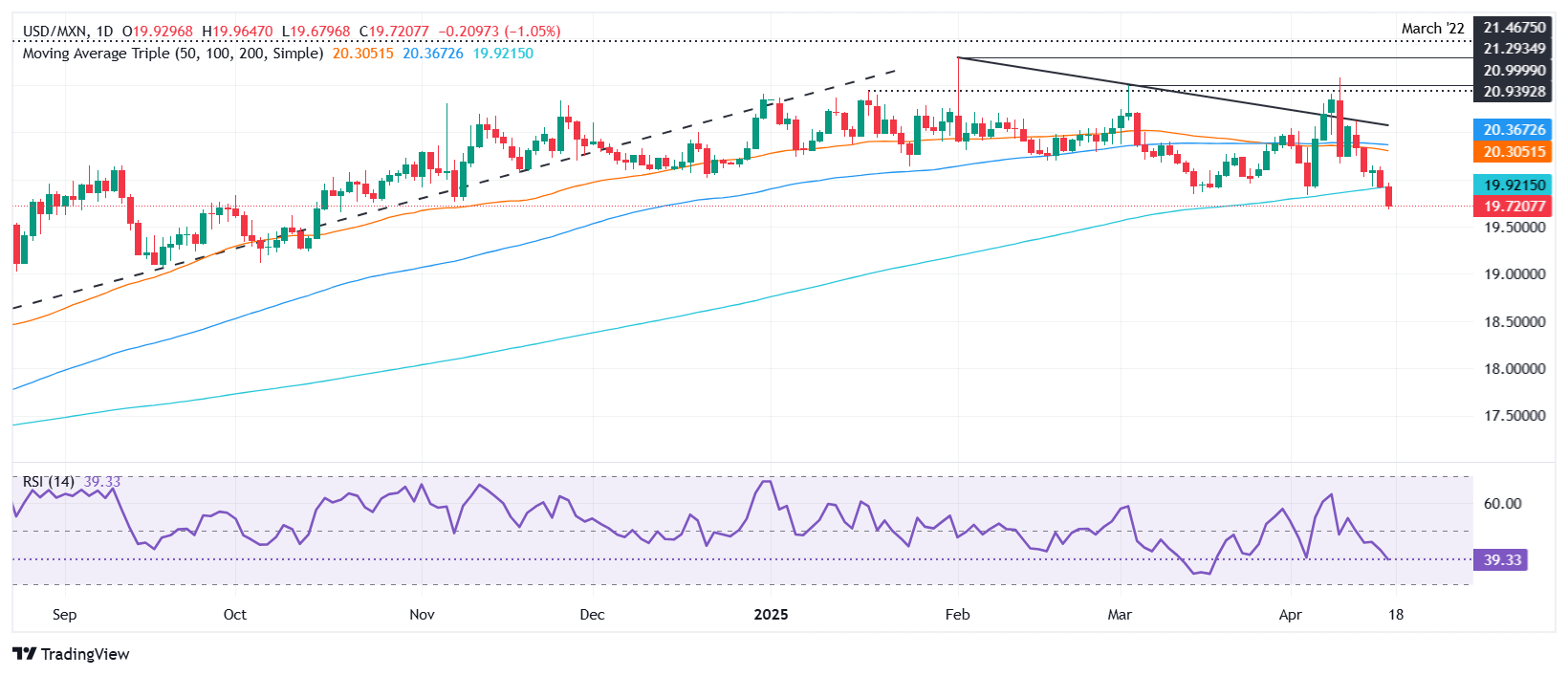Created
: 2025.04.18














![]() 2025.04.18 04:26
2025.04.18 04:26
The Mexican Peso rallied against the US Dollar on Thursday after US President Donald Trump and Mexican President Claudia Sheinbaum held a phone call that both said was "very productive." This and a weaker Greenback sent the USD/MXN drifting lower, exchanging hands at 19.69, down 1.14%.
Trading in Mexico is closed in observance of Easter holidays. Although Mexico's economic docket remained absent this week, it will gather traction next week with the release of Retail Sales, mid-month inflation for April, and Economic Activity data.
So far, Mexico has dodged additional tariffs that have already been imposed since March 4, when Trump enacted duties of 25% on most imports, including steel, aluminum, cars and auto parts. On April 14, the White House decided to apply 21% tariffs on tomatoes.
Across the border, US President Trump complained about US Federal Reserve (Fed) Chair Jerome Powell, saying that the Fed is "too late" on slashing rates due to decreased oil and grocery prices.
US jobs data and Building Permits fared better than expected. On the contrary, Housing Starts plunged, indicating that housing construction is slowing down.
In the docket, Mexico will feature Retail Sales, mid-month inflation for April, and economic activity for February until next week.
The USD/MXN uptrend is questionable with sellers sending the pair drifting below the 20.00 figure and clearing the 200-day Simple Moving Average (SMA) of 19.87. The Relative Strength Index (RSI) turned bearish, so a further confirmation of a daily close beneath the 200-day SMA would pave the way to challenge 19.50. In that outcome, the following support would be the 19.00 figure.
Conversely, if buyers push the USD/MXN exchange rate above 20.00, this could open the door to test the April 14 high of 20.29, which would open the door to the 50-day and 100-day SMA confluence near 20.29-20.35, followed by the 20.50 resistance.

The Mexican Peso (MXN) is the most traded currency among its Latin American peers. Its value is broadly determined by the performance of the Mexican economy, the country's central bank's policy, the amount of foreign investment in the country and even the levels of remittances sent by Mexicans who live abroad, particularly in the United States. Geopolitical trends can also move MXN: for example, the process of nearshoring - or the decision by some firms to relocate manufacturing capacity and supply chains closer to their home countries - is also seen as a catalyst for the Mexican currency as the country is considered a key manufacturing hub in the American continent. Another catalyst for MXN is Oil prices as Mexico is a key exporter of the commodity.
The main objective of Mexico's central bank, also known as Banxico, is to maintain inflation at low and stable levels (at or close to its target of 3%, the midpoint in a tolerance band of between 2% and 4%). To this end, the bank sets an appropriate level of interest rates. When inflation is too high, Banxico will attempt to tame it by raising interest rates, making it more expensive for households and businesses to borrow money, thus cooling demand and the overall economy. Higher interest rates are generally positive for the Mexican Peso (MXN) as they lead to higher yields, making the country a more attractive place for investors. On the contrary, lower interest rates tend to weaken MXN.
Macroeconomic data releases are key to assess the state of the economy and can have an impact on the Mexican Peso (MXN) valuation. A strong Mexican economy, based on high economic growth, low unemployment and high confidence is good for MXN. Not only does it attract more foreign investment but it may encourage the Bank of Mexico (Banxico) to increase interest rates, particularly if this strength comes together with elevated inflation. However, if economic data is weak, MXN is likely to depreciate.
As an emerging-market currency, the Mexican Peso (MXN) tends to strive during risk-on periods, or when investors perceive that broader market risks are low and thus are eager to engage with investments that carry a higher risk. Conversely, MXN tends to weaken at times of market turbulence or economic uncertainty as investors tend to sell higher-risk assets and flee to the more-stable safe havens.
![]()
Created
: 2025.04.18
![]()
Last updated
: 2025.04.18

FXStreet is a forex information website, delivering market analysis and news articles 24/7.
It features a number of articles contributed by well-known analysts, in addition to the ones by its editorial team.
Founded in 2000 by Francesc Riverola, a Spanish economist, it has grown to become a world-renowned information website.
We hope you find this article useful. Any comments or suggestions will be greatly appreciated.
We are also looking for writers with extensive experience in forex and crypto to join us.
please contact us at [email protected].
Disclaimer:
All information and content provided on this website is provided for informational purposes only and is not intended to solicit any investment. Although all efforts are made in order to ensure that the information is correct, no guarantee is provided for the accuracy of any content on this website. Any decision made shall be the responsibility of the investor and Myforex does not take any responsibility whatsoever regarding the use of any information provided herein.
The content provided on this website belongs to Myforex and, where stated, the relevant licensors. All rights are reserved by Myforex and the relevant licensors, and no content of this website, whether in full or in part, shall be copied or displayed elsewhere without the explicit written permission of the relevant copyright holder. If you wish to use any part of the content provided on this website, please ensure that you contact Myforex.
Myforex uses cookies to improve the convenience and functionality of this website. This website may include cookies not only by us but also by third parties (advertisers, log analysts, etc.) for the purpose of tracking the activities of users. Cookie policy